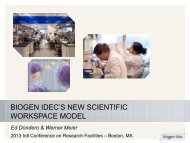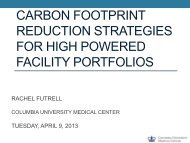Animal Research Facilities 2011 - Tradeline, Inc.
Animal Research Facilities 2011 - Tradeline, Inc.
Animal Research Facilities 2011 - Tradeline, Inc.
Create successful ePaper yourself
Turn your PDF publications into a flip-book with our unique Google optimized e-Paper software.
Flexible, efficient solutions for<br />
multispecies program fluctuations<br />
Boehringer Ingelheim Vetmedica, <strong>Inc</strong>.<br />
Kevin Fowler – Associate Director, R&D Operations<br />
The flexibility/operating efficiency/capital budget sweet spot is being<br />
redefined for vivariums tasked with supporting multiple species,<br />
rapidly changing research priorities, and fluctuating space needs.<br />
Kevin Fowler sets out Boehringer-Ingelheim’s demanding criteria for<br />
holding and procedure space that adapts rapidly across expanding<br />
and contracting studies involving mice, rats, pigs, dogs, horses, and<br />
cattle. He examines findings on layouts and adjacencies, holding room<br />
configurations, finishes, decontamination, and cutting edge flexibility<br />
features that include a split indoor/outdoor vivarium. He details plans<br />
for versatile feed and water distribution, waste treatment, and facility<br />
flows for large animals, small animals, and staff.<br />
Decontamination for large animal areas:<br />
lessons learned on VHP versus ClO2 Oregon Health & Science University<br />
Rick Doughty – Associate Director for Administration<br />
Full decontamination of large animal areas is proving to be a big<br />
hurdle for facility operating staff looking to move to either vaporized<br />
hydrogen peroxide (VHP) or chlorine dioxide (ClO ). The technologies<br />
2<br />
and methods that work for rodent facilities may not be equally<br />
effective for large animal housing —a complication that has<br />
significant operating cost repercussions. Rick Doughty documents<br />
Oregon Health & Science University’s experience testing and<br />
implementing both VHP and ClO in an array of animal area types,<br />
2<br />
sizes, and conditions. He reports on the direction their research is<br />
taking, staff preferences, training requirements, and costs.<br />
Vivarium renovations to meet European<br />
caging standards<br />
Novartis Institutes for BioMedical <strong>Research</strong><br />
Carmine Bianco, MBA, CMAR, RLATg – Head, <strong>Animal</strong> Care Operations<br />
Many organizations are adopting the new European caging standards<br />
for animal housing to enhance animal welfare, standardize operating<br />
procedures between global programs, and safeguard the quality<br />
of biomedical research. The minimum enclosure volumes and<br />
enrichment requirements set out in the ETS-123 guidelines mean that<br />
the old room size, utilities, and capacity planning metrics no longer<br />
apply. Carmine Bianco illustrates the effect of ETS-123 on Novartis’<br />
operating capacity calculations and the renovations under way to<br />
upgrade caging equipment for EU compliance. He identifies emerging<br />
best practices for realigning existing spaces and programs with<br />
multiple regulatory standards.<br />
8<br />
Monday; Nov. 7<br />
Attend all of the General Sessions below<br />
<strong>Inc</strong>reasing demand for zebrafish: facility<br />
planning and operations<br />
Memorial Sloan-Kettering Cancer Center and the Weill Cornell Medical College<br />
Neil S. Lipman, VMD – Professor and Director, Center of Comparative Medicine and Pathology<br />
Zebrafish continue to grow as an important and exciting animal model<br />
in developmental biology, cancer, genetics, and immunology. The<br />
ability to support this emerging model provides a key recruitment and<br />
retention advantage. Neil Lipman scopes out the science drivers behind<br />
the robust growth of this model system as he profiles space, staffing,<br />
and management considerations as well as the associated challenges<br />
and solutions for each. He details planning and design considerations<br />
in the development of core shared fish facilities at Memorial<br />
Sloan-Kettering Cancer Center and Weill Cornell Medical Center.<br />
New research methods and technologies<br />
for large animal facilities<br />
Department of Homeland Security, Plum Island <strong>Animal</strong> Disease Center<br />
James Johnson – Director, Office of National Laboratories<br />
Emerging research requirements and large animal handling processes<br />
coming out of the Plum Island <strong>Animal</strong> Disease Center should factor<br />
heavily in operational planning, design, and equipment decisions<br />
for vivarium upgrades and new construction. Jamie Johnson sets<br />
out the coming science agenda for animal pathogens and what it<br />
means for capacity, flexibility, containment, and technology planning.<br />
He identifies innovative solutions for program limiting and aging<br />
facility infrastructure. He also illustrates lessons learned thus far<br />
from planning the replacement DHS facility, the National Bio and<br />
Agro-Defense Facility (NBAF). He scopes out the Plum Island relocation<br />
strategy designed to ensure research continuity and safety.<br />
High-value shutdowns: key to research<br />
uptime<br />
University of Colorado Denver<br />
Jori K. Leszczynski, DVM, DACLAM – Director, OLAR & University Veterinarian<br />
A costly shutdown can be the best investment for improved research<br />
productivity. Here, see the argument for performing a full vivarium<br />
reboot for decontamination instead of a maintain-while-operational<br />
service model. Jori Leszczynski sets out a process that delivers<br />
maximum value shutdown maintenance packages by reconciling a<br />
detailed menu of maintenance tasks with the diminishing returns<br />
of extended shutdown durations. She examines decisions on<br />
schedule, budget, labor headcount, and strategies for swing space,<br />
decontamination, and recommissioning. She documents surprises<br />
discovered in a vivarium shutdown and restart that have implications<br />
for overall facility management and research productivity.





